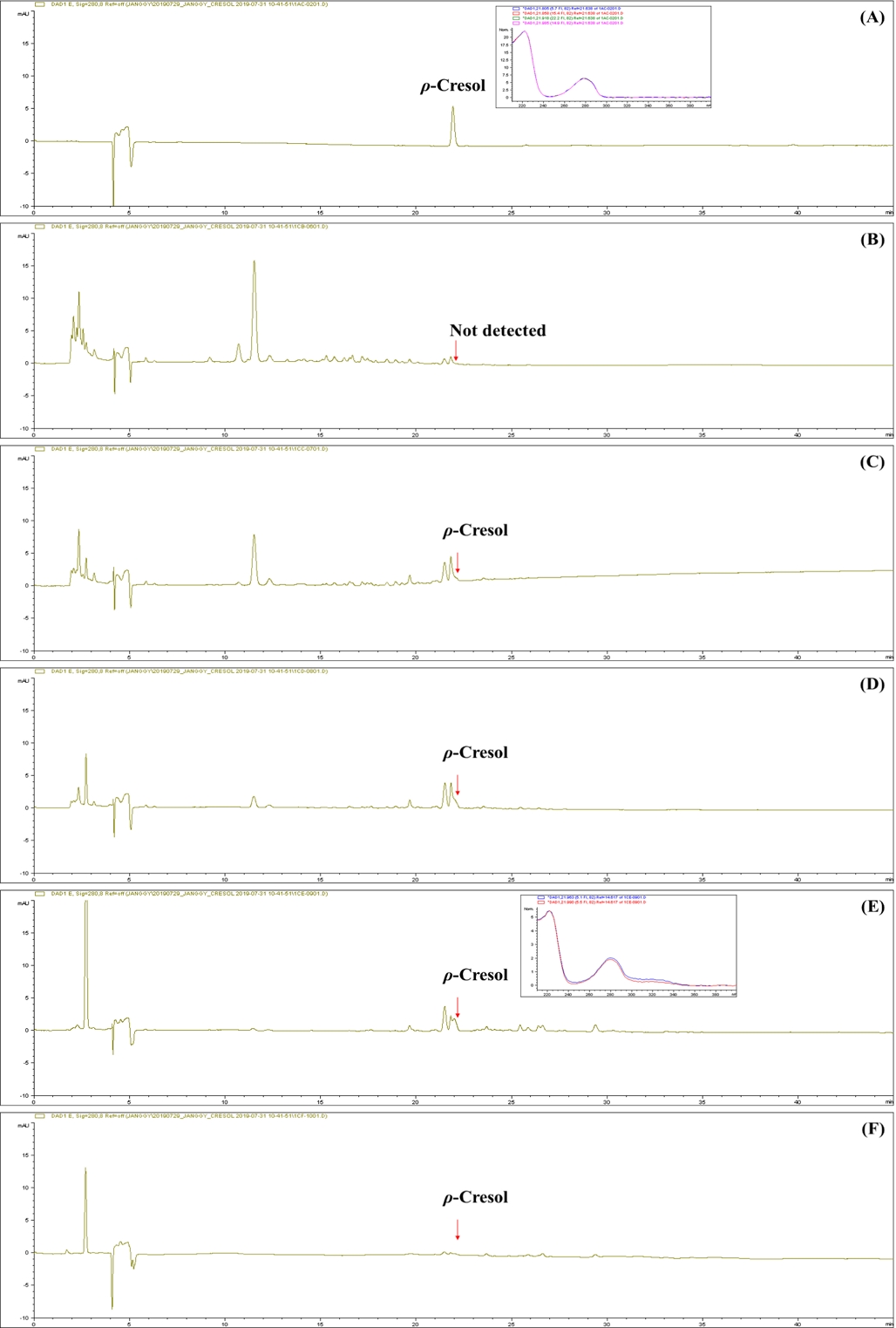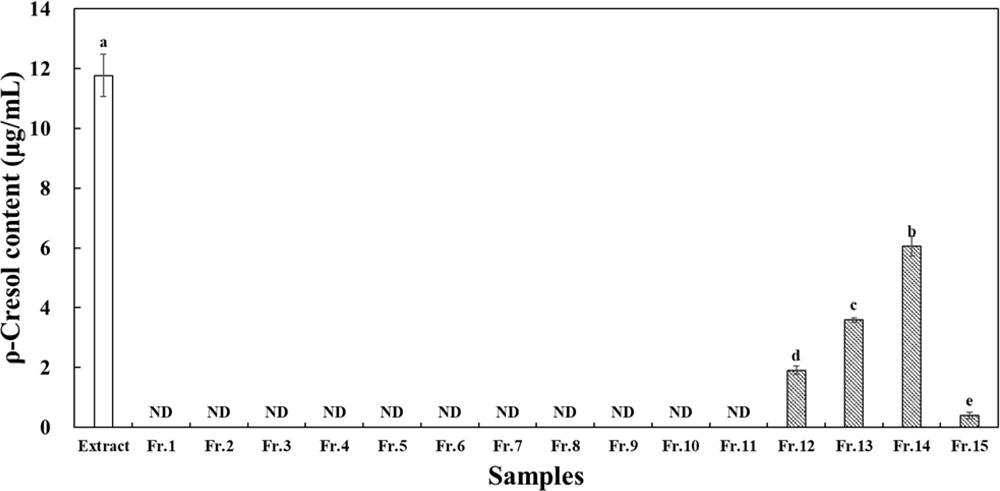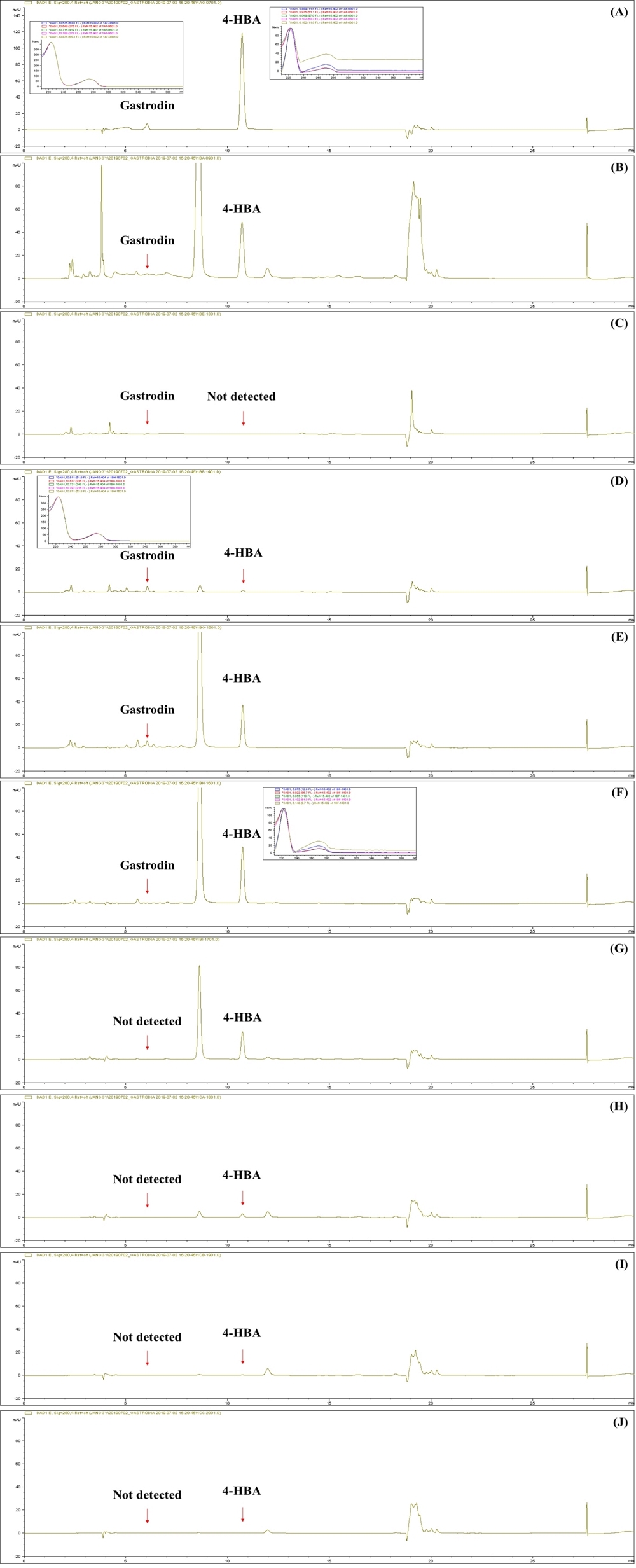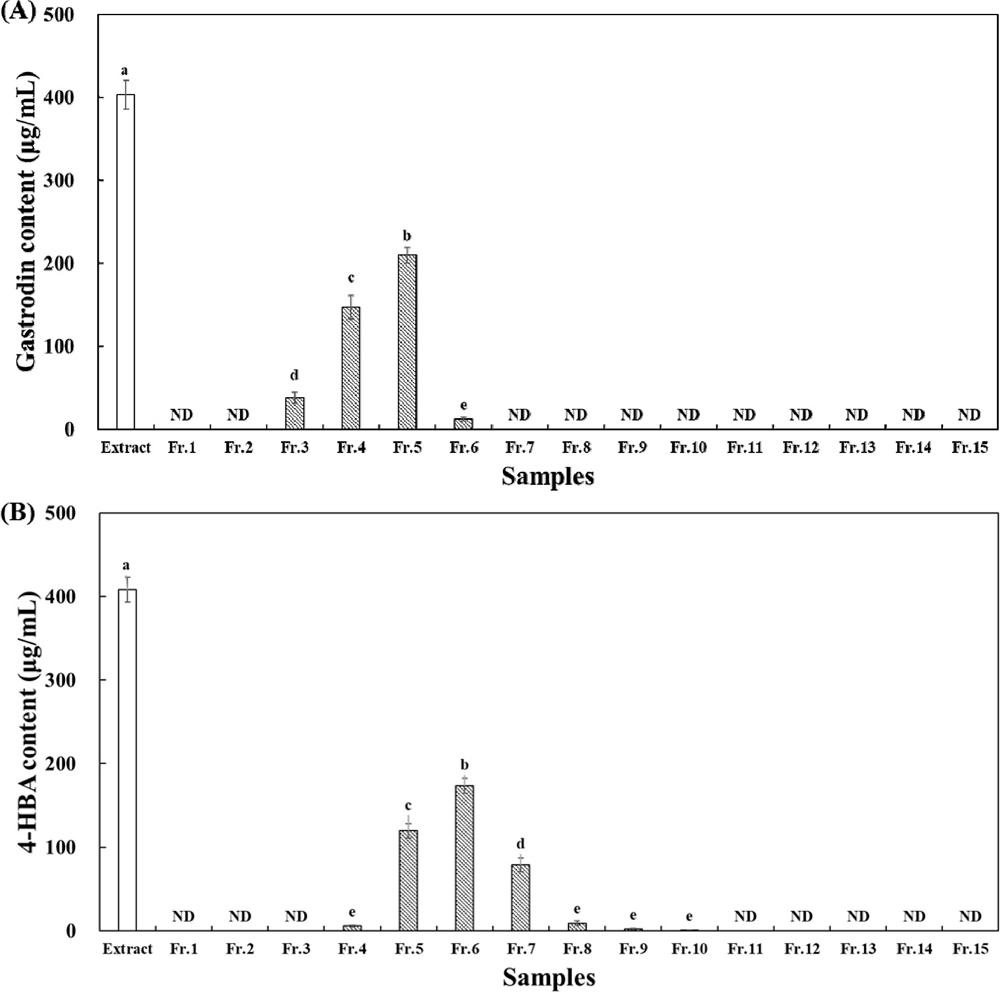
Diaion HP-20 레진을 이용한 천마 추출물의 불쾌취 제거
 ; Je Hun Choi2
; Je Hun Choi2 ; Su Ji Choi3
; Su Ji Choi3 ; Seung Eun Lee4
; Seung Eun Lee4 ; Kyung Hye Seo5
; Kyung Hye Seo5 ; Dong Hwi Kim6
; Dong Hwi Kim6 ; Yun Jeong Jee7
; Yun Jeong Jee7 ; Heon Sang Jeong8
; Heon Sang Jeong8 ; Yoon Jeong Lee9, †
; Yoon Jeong Lee9, †
This is an open access article distributed under the terms of the Creative Commons Attribution Non-Commercial License (http://creativecommons.org/licenses/by-nc/3.0/) which permits unrestricted non-commercial use, distribution, and reproduction in any medium, provided the original work is properly cited.
Abstract
Although Gastrodia elata contains the valuable, bio-active compounds gastrodin and 4-hydroxybenzyl alcohol (4-HBA), it also contain ρ-cresol, which is a major source of an objectionable pig slurry-like odor. Accordingly, this study was performed to determine the deodorization effect of Diaion HP-20 resin on a G. elata extract.
Using Diaion HP-20 with an increasing concentration of ethanol, an extract of G. elata was fractionated into 15 fractions, which were anlayzed to determine their concentrations of active compounds and ρ-cresol. The gastrodin, 4-HBA, total phenolics, and ρ-cresol concentrations of the G. elata extract were 403.13, 408.15, 2,476.09, and 11.77 ㎍/㎖, respectively. Among the different fractions, gastrodin and 4-HBA were detected in fractions 3 to- 6, and 4 to- 10, respectively whereas total phenolics were detected in all samples, with fractions 5 to- 7 being characterized by higher concentrations than were the other fractions. ρ-Cresol was detected in fractions 12 to- 15, at concentrations ranging from 0.39 ㎍/㎖ to 6.05 ㎍/㎖ with the highest concentration detected in fraction 14. The fractions containing ρ-cresol could be selectively separated from the G. elata extract without the loss of major bio-active compounds such as gastrodin and 4-HBA.
The results of this study indicate that a deodorizing method using Diaion HP-20 resin can be considered for improving the sensory qualities of G. elata extract without a loss of the major bio-active compounds.
Keywords:
Gastrodia elata Blume, Deodorization, Diaion HP-20 Resin, Objectionable Odor서 언
천마 (Gastrodia elata Blume)는 난초과에 속하는 다년생 초본 식물의 뿌리를 지칭한다. 천마는 엽록소가 없어 탄소동화 작용을 통한 영양물질의 합성이 불가능하고 뿌리가 없어 뽕나무 버섯과 편리공생을 통해 생장한다 (Sin, 1980; Lee, 1990). 천마는 주로 한국, 일본 및 중국에서 재배하고 있으며 고혈압, 중풍, 두통, 어지럼증, 스트레스 및 피로 등에 효과적인 것으로 알려져 있다 (Huang, 1985; Huh et al., 1998). 천마의 주요 성분으로 gastrodin과 4-hydroxybenzyl alcohol (4-HBA)이 있으며, 이외에 vanilly alcohol, benzaldehydes, β-sitosterol 등을 함유하는 것으로 보고되었다 (Zhou et al., 1979; Kang et al., 2002; Chang and Ahn, 2011).
그러나 천마 특유의 불쾌한 냄새, 비린맛, 쓴맛으로 인하여 섭취에 어려움을 나타내고 있으며 비린맛과 쓴맛은 천마의 가공과정에서 쉽게 제거되지만 불쾌취는 쉽게 제거되지 않고 오래 잔존하여 식품 원료로서의 활용에 큰 장애요인으로 작용한다 (Chang and Ahn, 2011). 천마의 불쾌취에 대한 원인 성분은 ρ-cresol (4-methylphenol)로 보고되어 있으며 돼지 분변 냄새로 묘사된다 (Chang and Ahn, 2011; Song et al., 2017). 이러한 천마의 관능적인 문제를 해결하기 위하여 다양한 연구가 진행되었다. 대표적으로 건조 (Lee et al., 2002; Choi et al., 2011b; Chu et al., 2012), 발효 (Chang and Ahn 2011; Song et al., 2017), 증숙 (Lee et al., 2003) 등의 가공방법을 통해 천마의 관능적 문제점을 개선함으로서 활용성을 높이고자 하였다. 그러나 대부분의 방법이 천마의 불쾌취를 제거하는 것에 있어 제한된 효과를 나타내었다.
다공성 합성 흡착제는 음료, 식품 첨가제, 기능성 식품 원료 및 의약품 제조 등의 분야에서 정제, 탈취 등 다양한 목적으로 사용되고 있다 (Kwak et al., 2001; Jung et al., 2009; Choi et al., 2011a). 그러나 천마의 관능적 품질을 개선하기 위한 목적으로 다공성 합성 흡착제를 활용하기 위한 연구는 수행된 바 없다.
따라서 본 연구에서는 다공성 합성흡착제를 이용하여 천마에서 ρ-cresol을 기준으로 불쾌취 제거 효과를 확인하고, 그에 따른 기능성분의 손실 여부를 살펴보고자 하였다.
재료 및 방법
1. 재료 및 시약
재료는 경상북도 상주시 소재의 천마 (Gastrodia elata Blume)가공업체로부터 천마 외 다른 원료가 사용되지 않은 천마 열수 추출물을 구입하여 사용하였다. 실험에 사용한 천마 추출물은 생천마에 동량의 물을 가하고 열수 추출 후 압착하여 제조하였으며, 흡착제는 다공성의 비극성 합성흡착제로서 HP-20 (Diaion HP-20, Supelco Inc., Bellefonte, PA, USA)을 사용하였고, 용출 용매로 발효주정과 증류수를 사용하였다. 분석에 사용한 gastrodin, 4-HBA 및 ρ-cresol은 Sigma-Aldrich (St. Louis, MO, USA)로부터 구입하였다.
2. 합성흡착제를 이용한 분획물 제조
천마 추출물에 대한 HP-20의 탈취 효과를 확인하기 위하여 HP-20을 충진한 컬럼에서 분획물을 제조하였다. 분획물의 제조는 천마 추출물 50㎖을 직경 25㎜, 길이 100㎜로 HP-20을 충진 한 오픈 컬럼에 로딩 후 100㎖의 증류수, 10%, 20%, 30%, 40%, 50% 및 95% 에탄올 용액을 순차적으로 가하여 용출시켰으며, 각 분획은 50㎖씩 분취하여 분석에 사용하였다.
3. 천마 추출물과 분획물의 주요 성분 및 ρ-cresol 함량
천마 분획물 중 주요 기능성분의 분포를 확인하기 위하여 gastrodin과 4-HBA의 함량을 분석하였다. Gastrodin과 4-HBA의 분석에는 HPLC-UVD (1200 series, Agilent Technologies Inc., Santa Clara, CA, USA)와 Synergy fusion-RP18 컬럼 (250㎜ × 4.6㎜, 4㎛, Phenomenex Inc., Torrance, CA, USA)을 사용하였다. 이동상은 0.1% acetic acid/acetonitrile (A)과 0.1% acetic acid/water (B) 기울기 조건 (0 - 5 min: 5 - 5% A, 5 - 15 min: 5 - 10% A, 15 - 16 min: 10 - 95% A, 16 - 24 min: 95 - 95% A, 24 - 25 min: 95 - 5% A, 25 - 30 min: 5 - 5% A), 컬럼온도 30℃, 유속 1.0 ㎖/min, 주입량 10㎕, 검출파장 280㎚로 분석하였다. 주요 성분의 정성은 표준물질과 시료 chromatogram 중 peak의 retention time과 UV-spectrum을 통해 확인하였다. 정량을 위하여 표준물질로서 gastrodin과 4-HBA를 사용하였으며 표준 곡선을 작성하기 위한 농도 범위는 0.03 - 0.5 ㎎/㎖이었다. Gastrodin과 4-HBA의 회귀식은 y = 163.19x - 2.7217 (R2 = 0.9994)과 y = 2741x - 6.375 (R2 = 0.9999)이었다.
천마 분획물 중 총 페놀 성분의 분포를 확인하기 위하여 분획물 중 총 페놀 함량을 측정하였다 (Dewanto et al., 2002). 각 분획물 100 ㎕에 2% Na2CO3 용액 2 ㎖를 가한 후 3 분간 방치하고 1 N Folin-Ciocalteu reagent (Sigma-Aldrich Co., St. Louis, MO, USA) 100 ㎕를 가하고 혼합하였다. 반응액은 상온에서 30 분간 방치 후 750 ㎚에서 흡광도를 측정하였다. 표준물질로 gallic acid (Sigma-Aldrich Co., St. Louis, MO, USA)를 사용하여 검량선을 작성하고 총 페놀 함량은 시료 1 ㎖ 중 ㎎·gallic acid로 나타내었다.
천마 추출물에 대한 탈취효과를 확인하기 위하여 분획물 중 ρ-cresol 함량을 분석하였다. 분석에는 HPLC-UVD와 Synergy fusion-RP18 컬럼을 사용하였다. 이동상은 acetonitrile (A)과 물 (B) 기울기 조건 (0 - 5 min: 18 - 18% A, 5 - 20 min: 18 - 40% A, 20 - 25 min: 40 - 40% A, 25 - 45 min: 40 - 50% A), 컬럼 온도 30℃, 유속 0.8 ㎖/min, 주입량 10 ㎕, 검출파장 280 ㎚로 분석하였으며, 정성은 표준물질과 시료 chromatogram 중 peak retention time과 UV-spectrum을 통해 확인하였다. 표준품으로 ρ-cresol을 사용하여 0.001 - 0.1 ㎎/㎖의 농도범위에서 표준곡선을 작성하였으며, 표준곡선으로부터 얻은 회귀식은 y = 6,990.09x - 0.533 (R2=0.9999)이었다.
4. 통계분석
통계분석은 SPSS (Statistical Package for the Social Science, Ver. 23.0 SPSS Inc., Chicago, IL, USA)를 이용하여 추출물과 분획물의 평균과 표준편차를 산출하고 시료 간 차이 유무를 One-way ANOVA (Analysis of variation)로 분석한 후 Duncan's Multiple Range Test (DMRT)를 이용하여 검정하였으며 (p < 0.05), 분획물 중 주요 성분의 분포간의 상관성 분석은 Pearson’s correlation coefficient로 유의성을 검정하였다.
결과 및 고찰
1. 천마 추출물과 분획물의 ρ-cresol 함량
천마 (Gastrodia elata Blume)의 불쾌취와 관련하여 다양한 성분에 의한 것으로 보고된 연구 결과도 있으나 (Lee et al., 2002) 가장 큰 원인 성분은 ρ-cresol이며 천마 특유의 냄새와 ρ-cresol의 관능적 특성이 매우 유사하여 (Song et al., 2017), ρ-cresol 함량을 불쾌취 제거에 대한 판단 지표로 사용하는 것은 적절하다.
따라서 본 연구에서는 천마 추출물에서 HP-20의 불쾌취 제거 효과를 확인하기 위하여 HP-20을 통과시켜 제조한 분획물 중 ρ-cresol의 분포를 확인하였다 (Fig. 1, 2). 천마 추출물의 ρ-cresol 함량은 11.77 ± 0.71㎍/㎖이었다. HP-20에서 분리한 분획물 중 ρ-cresol은 12 번 분획에서부터 검출되기 시작하여 14 번 분획에서 가장 높은 함량을 나타내었다. 12, 13, 14 및 15 번 분획의 ρ-cresol 함량은 각각 1.90 ㎍/㎖, 3.59 ㎍/㎖, 6.05 ㎍/㎖ 및 0.39 ㎍/㎖이었으며 총 함량은 11.92 ± 0.61 ㎍/㎖로 추출물과 유사한 함량을 나타내었다. 추출물과 분획물의 함량이 오차 범위 내의 유사한 수준이라는 결과는 흡착된 ρ-cresol이 11 번 분획까지 용출되지 않고 12 번 분획에서부터 선택적으로 분리되었음을 의미한다. 따라서 12 번 분획에 해당하는 50% 에탄올에서부터 분리되었을 것으로 추정된다.

Chromatograms and UV-spectra for ρ-cresol of fractions from Gastrodia elata extract.Samples: (A); standard, (B); fraction 11, (C); fraction 12, (D); fraction 13, (E); fraction 14, (F); fraction 15.

ρ-Cresol content of fractions from Gastrodia elata extract.ND; Not detected. *Different letters on the bars means a significant difference by Duncan’s Multiple Range Test (DMRT, p < 0.05).
천마의 향기 성분에 대한 연구에서 생천마와 건조 천마의 향기성분을 비교하였을 때 생천마에서 확인된 39 종의 휘발성 성분 중 일부 성분은 건조 후 검출되지 않았으며 건조 천마에서는 25 종의 휘발성 성분이 확인되었다. 그러나 건조 과정에서 일부 휘발성 성분은 완전히 제거되었으나, ρ-cresol은 건조 후에도 상당량 잔존하여 건조에 의한 불쾌취 제거 효과는 한정적이었다 (Lee and Kim, 1997). Song 등 (2017)의 연구에서 천마의 이취를 제거하기 위한 방법으로 유산균 발효를 이용하였다. 발효균으로 Pediococcus inopinatus BK-3, Lactobacillus sakei C-11, Lactobacillus plantarum VL-1를 사용하였을 때 L. sakei C-11가 이취 제거에 가장 효과적이었으며 ρ-cresol이 160㎍/g에서 80㎍/g 수준으로 감소하여 이취 저감 효과를 나타내었으나 건조방법과 같이 완전히 제거되지 않았다. ρ-Cresol의 끓는점은 상압 하에서 202℃로 물의 끓는점보다 매우 높다 (Gibbs, 1927). 따라서 ρ-cresol은 가열에 의한 증발이나 분해시키는 방법으로는 제거하기 어려울 것으로 판단된다.
ρ-Cresol 제거를 목적으로 가열하거나 분해시키는 방법이 아닌 흡착제를 이용한 연구에서 polystyrene과 divinylbenzene으로 이루어진 합성 흡착제를 이용하여 ρ-cresol과 유사한 물질이 포함된 혼합물로부터 ρ-cresol을 선택적으로 분리하는 것이 가능하였으며, 흡착량은 흡착제의 종류나 조건에 따라 1 ㎏당약 216 - 260 g 수준이었다 (Anasthas and Gaikar, 1999). 천마 추출물에는 다양한 성분이 존재하지만, 천마 추출물에 존재하는 다른 성분을 배제하고 ρ-cresol 함량 (약 12 ㎍/㎖)으로만 계산한다면 합성 흡착제 1 ㎏은 천마 추출물 18,000 - 20,000ℓ에 해당하는 ρ-cresol을 흡착할 수 있어 ρ-cresol 제거를 위한 방법으로서 활용 가능성이 높을 것으로 판단된다.
2. 천마 추출물과 분획물의 gastrodin과 4-HBA 함량
탈취 공정에서는 목적 성분의 제거뿐 아니라 중요 성분의 손실을 최소화하는 것도 매우 중요하다. 천마 추출물의 불쾌취 성분인 ρ-cresol의 선택적 제거과정에서 주요 기능성분의 손실 여부를 확인하기 위하여 gastrodin과 4-HBA를 분석한 결과는 Fig. 3, 4와 같다.

Chromatograms and UV-spectra for gastrodia and 4-hydroxybenzyl alcohol of fractions from Gastrodia elata extract.Samples: (A); standards, (B); extract, (C); fraction 3, (D); fraction 4, (E); fraction 5, (F); fraction 6, (G); fraction 7, (H); fraction 8, (I); fraction 9, (J); fraction 10.

Gastrodin and 4-hydroxybenzyl alcohol contents of fractions from Gastrodia elata extract. (A) and (B) were showed gastrodin and 4-HBA contents of fractions, respectively. ND; Not detected. *Different letters on the bars means a significant difference by Duncan’s Multiple Range Test (DMRT, p < 0.05).
4-HBA에 당이 결합되어 더 강한 친수성을 갖는 gastrodin은 3 번에서 6 번 분획까지 분포하였다. 3, 4, 5, 6 번 분획의 gastrodin 함량은 각각 37.93 ㎍/㎖, 146.62 ㎍/㎖, 209.47 ㎍/㎖ 및 12.42 ㎍/㎖로 총 함량은 406.45 ± 26.94㎍/㎖로 추출물 (403.13 ± 17.4 ㎍/㎖)과 비교하여 대부분의 gastrodin이 20% 이하 농도의 에탄올 용액에서 회수되는 것으로 확인되었다. Gastrodin과 함께 천마의 주요 기능성분으로 알려진 4-HBA 함량을 분석한 결과, 4 번 분획에서 10 번 분획 사이에 분포하였으며 분획별 함량은 4, 5, 6, 7, 8, 9 및 10 번 분획에서 각각 5.74 ㎍/㎖, 119.57 ㎍/㎖, 173.56 ㎍/㎖, 78.95 ㎍/㎖, 9.21 ㎍/㎖, 1.97 ㎍/㎖ 및 0.43 ㎍/㎖으로 5 - 7 번 분획에서 대부분 용출되었으며 10% 에탄올 용액에서부터 분리되기 시작하여 40% 에탄올 용액에서 모두 회수되었다. 회수된 4-HBA의 총 함량은 389.43 ± 13.98 ㎍/㎖로 추출물에 존재하는 408.15 ± 14.57 ㎍/㎖ 대비 95% 이상의 회수율을 나타내어 산업적 이용가치가 충분할 것으로 판단되었다.
천마의 gastrodin과 gastrodin의 aglycone인 4-HBA는 항염증, 항경련, 진통억제, 기억력 개선, 항불안 효과가 있으며 기능 성분 중 높은 비율을 차지하는 주요 약리 성분으로 알려져 있어 (Yun-Choi et al., 1998; Hayashi et al., 2002; Kim et al., 2012; Kim and Park, 2013), gastrodin과 4-HBA 함량 감소는 결국 주요 기능성분의 감소로 볼 수 있어 탈취와 같은 가공과정에서 손실이 최소화되어야 한다.
3. 천마 추출물과 분획물의 총 페놀 함량
천마의 대표적인 페놀성분으로서 ρ-cresol과 함께 4-HBA와 4-HBA의 배당체인 gastrodin, 한 개에서 세 개의 gastrodin으로 구성된 다양한 parishin 류가 존재하여 (Yang et al., 2007), 탈취 후 분획물에 존재하는 페놀성분의 분포를 확인하고자 하였다. 분획물 중 총 페놀 함량을 확인한 결과는 Fig. 5와 같다.

Total phenolics content of fractions from Gastrodia elata extract.Total phenolics content of Gastrodia elata extract was 2,476.09 ± 93.12㎍/㎖. *Different letters on the bars means a significant difference by Duncan’s Multiple Range Test (DMRT, p < 0.05).
추출물의 총 페놀 함량은 2,476.09 ㎍/㎖이었으며, 분획물의 총 페놀 함량은 2,260.56 ± 140.06 ㎍/㎖로 91% 이상의 회수율을 나타내었으며, 불쾌취가 분포되어 있는 12 번에서 15 번 분획을 제외하면 1,771.47 ± 62.56 ㎍/㎖로 전체 페놀 성분 중 71%를 회수할 수 있을 것으로 판단된다. 분획 중 페놀성분의 분포로 보았을 때, gastrodin과 4-HBA가 높은 농도로 분포되어 있는 5 번과 6 번 분획에서 가장 높은 함량을 나타내었다. 이러한 결과를 보았을 때 분획 중 5 번과 6 번 분획에 존재하는 페놀성분의 상당부분이 gastrodin과 4-HBA일 것으로 추정된다.
그러나 회수율이 71% 수준이기 때문에 회수되지 않은 29%로 인한 활성의 변화와 본 연구에서 정성, 정량하지 않은 페놀성분과 gastrodin 전구체 등 유사물질에 대한 연구가 추가적으로 이루어져야 할 것으로 판단된다. 천마의 주요 기능성분인 gastrodin의 전구체는 parishin류로 citric acid에 한 개에서 세 개의 gastrodin이 결합되어 있는 강한 극성 성분으로 알려져 있어 (Lin et al., 1996), HP-20에 의한 탈취 시 앞쪽 친수성 분획에 포함될 것으로 추정된다.
4. 천마 분획물 중 주요 성분간의 상관성 분석
분획물 중 주요성분 분포간의 상관성을 확인한 결과는 Table 1과 같다. 분획물에 존재하는 기능성분과 불쾌취 성분 간의 분포는 gastrodin, 4-HBA 및 총 페놀 함량 간에는 양의 상관관계를 나타내어 분포가 유사하다는 것을 나타내었으며, 특히 4-HBA와 총 페놀 함량 간에는 0.889 (p < 0.01)의 높은 상관성을 보여 4-HBA의 함량이 총 페놀 함량 중 상당부분을 차지할 것으로 추정된다. 그에 반해 불쾌취 성분인 ρ-cresol은 gastrodin, 4-HBA 및 총 페놀 함량과 유의적인 상관성을 보이지 않았으며 음의 상관관계를 나타내어 기능성분과 분포가 다른 것으로 판단되었다.

Correlation among gastrodin, 4-HBA, total phenolics, and ρ-cresol contents of fractions from Gastrodia elata extract.
본 연구 결과, 천마의 이용 장애요인으로 작용하는 불쾌취를 제거하기 위하여 흡착제로서 HP-20과 주정을 사용하였을 때, gastrodin과 4-HBA와 같은 기능성분의 손실을 최소화하면서 ρ-cresol을 선택적으로 분리할 수 있었다. 이는 천마의 기능적인 품질을 유지하면서 불쾌취를 제거할 수 있음을 뜻하며, 본 연구에서 제안하는 탈취 방법은 천마의 가공과 산업적 활용에 많은 도움을 줄 수 있을 것으로 사료된다.
Acknowledgments
본 연구는 농촌진흥청 원예특작시험연구사업 (과제번호: PJ01381301)의 지원에 의해 수행된 연구과제로서 이에 감사드립니다.
References
-
Anasthas HM and Gaikar VG. (1999). Adsorptive separations of alkylphenols using ion-exchange resins. Reactive and Functional Polymers. 39:227-237.
[https://doi.org/10.1016/S1381-5148(98)00008-X]

-
Chang YN and Ahn BY. (2011). Decrease in intrinsic objectionable odors and change of gastrodin contents in lactic acid treated Gastrodia elate Blume. Journal of the Korea Academia-Industrial Cooperation Society. 12:5056-5062.
[https://doi.org/10.5762/KAIS.2011.12.11.5056]

-
Choi SJ, Lee YS, Kim JK, Chung CK, Kang IJ and Lim SS. (2011a). Antioxidant activity of ripe fruit components of Rubus coreanus: Extraction using porous polymer resins. Korean Journal of Food Science and Technology. 43:149-155.
[https://doi.org/10.9721/KJFST.2011.43.2.149]

-
Choi SR, Jang I, Kim CS, You DH, Kim JY, Kim YG, Ahn YS, Kim JM, Kim YS and Seo KY. (2011b). Changes of components and quality in Gastrodiae rhizoma by different dry methods. Korean Journal of Medicinal Crop Science. 19:354-361.
[https://doi.org/10.7783/KJMCS.2011.19.5.354]

-
Chu HN, Kim JS, Kim KO and Jeong JK. (2012). Effect of functional components. Antioxidant activity and sensory characteristics of Gastrodiae rhizoma by different drying condition. Korea Journal of Herbology. 27:139-145.
[https://doi.org/10.6116/kjh.2012.27.6.139]

-
Dewanto V, Wu X and Liu RH. (2002). Processed sweet corn has higher antioxidant activity. Journal of Agricultural and Food Chemistry. 50:4959-4964.
[https://doi.org/10.1021/jf0255937]

-
Gibbs HD. (1927). Para-cresol. A new method of separating paracresol from its isomers and a study of the boiling point. Journal of the American Chemical Society. 49:839-844.
[https://doi.org/10.1021/ja01402a027]

-
Hayashi J, Sekine T, Deguchi S, Lin Q, Horie S, Tsuchiya S, Yano S, Watanabe K and Ikegami F. (2002). Phenolic compounds from Gastrodia rhizome and relaxant effects of related compounds on isolated smooth muscle preparation. Phytochemistry. 59:513-519.
[https://doi.org/10.1016/S0031-9422(02)00008-0]

- Huang ZL. (1985). Recent developments in pharmacological study and clinical application of Gastrodia elata in china. Chinese Journal of Modern Developments in Traditional Medicine. 5:251-254.
- Huh K, Kim JS, Kwon TK, Kim JA, Yong CC, Ha JH and Lee DU. (1998). The mechanism of anticonvulsive effect of the rhizoma of Gastrodia elata in pentylenetetrazole treated rats. Yakhak Hoeji. 42:330-335.
- Jung SH, Park KU, Kim JY, Park CK, Choi KS and Seo KI. (2009). Biological activities of crude polysaccharides and crude saponins from Salicornia herbacea. Korean Journal of Food Preservation. 16:109-114.
-
Kang TS, Kong YJ, Kwon HJ, Choi BK, Hong JG and Park YK. (2002). A studies on the chemical composition and in vitro biological activities of a hot water extracts of Gastrodia elata. Korean Journal of Mycology. 30:136-141.
[https://doi.org/10.4489/KJM.2002.30.2.136]

-
Kim HT and Park EJ. (2013). Change of major functional components of Gastrodia elata blume with cultivation conditions and harvest times. Korean Journal of Medicinal Crop Science. 21:282-288.
[https://doi.org/10.7783/KJMCS.2013.21.4.282]

-
Kim HT, Kim JA and Park EJ. (2012). Genetic diversity and metabolite analysis of Gastrodia elata by inter-simple sequence repeats(ISSR) markers. Korean Journal of Medicinal Crop Science. 20:440-446.
[https://doi.org/10.7783/KJMCS.2012.20.6.440]

- Kwak YS, Kyung JS, Kim SK and Wee JJ. (2001). An isolation of crude saponin from red-ginseng efflux by Diaion HP-20 resin adsorption method. Journal of the Korean Society of Food Science and Nutrition. 30:1-5.
- Lee BY, Yang YM and Han CK. (2002). Analysis of aroma pattern of Gastrodiae rhizoma by the drying conditions. Korean Journal of Food Science and Technology. 34:13-17.
- Lee JM, Kim IH and Kim SH. (2003). Optimal steaming condition of Gastrodia elata blume(Chunma) using response surface methodology(RSM). Journal of the Korean Society of Agricultural and Biotechnology. 46:107-112.
- Lee JW and Kim YK. (1997). Volatile flavor constituents in the rhizoma of Gastrodia elata. Agricultural Chemistry and Biotechnology. 40:455-458.
- Lee YM. (1990). In oriental medicine dictionary. Sammundang. Seoul, Korea. p.814.
-
Lin JH, Liu YC, Hau JP and Wen KC. (1996). Parishins B and C from rhizomes of Gastrodia elata. Phytochemistry. 42:549-551.
[https://doi.org/10.1016/0031-9422(95)00955-8]

- Sin KG. (1980). In sinssi herbology. Sumunsa. Seoul, Korea. p.288-290.
- Song YE, Lee IS, Song EJ, Choi MK, Han HA, Shin SH, Choi SR, Lee KK, Kim MK and Park SY. (2017). Changes of off-odor constituent and parishin derivatives of fermentation of Gastrodia elata rhizome by lactic acid bacteria strains. Korean Journal of Food and Nutrition. 30:973-982.
-
Yang XD, Zhu J, Yang R, Liu JP, Li L and Zhang HB. (2007). Phenolic constituents the rhizomes of Gastrodia elata. Natural Product Research. 21:180-186.
[https://doi.org/10.1080/14786410601081997]

-
Yun-Choi HS, Pyo MK and Park KM. (1998). Isolation of 3-O-(4'-hydroxybenzyl)-β-sitosterol and 4-[4'-(4"-hydroxybenzyloxy) benzyloxy] benzyl methyl ether from fresh tubers of Gastrodia elata. Archives of Pharmacal Research. 21:357-360.
[https://doi.org/10.1007/BF02975302]

- Zhou J, Yang YB and Yang CR. (1979). Chemical study on gastrodin and related compounds, separation and identification of chemical constitutes of Gastrodia elata B1. Acta Chimica Sinica. 37:183-189.